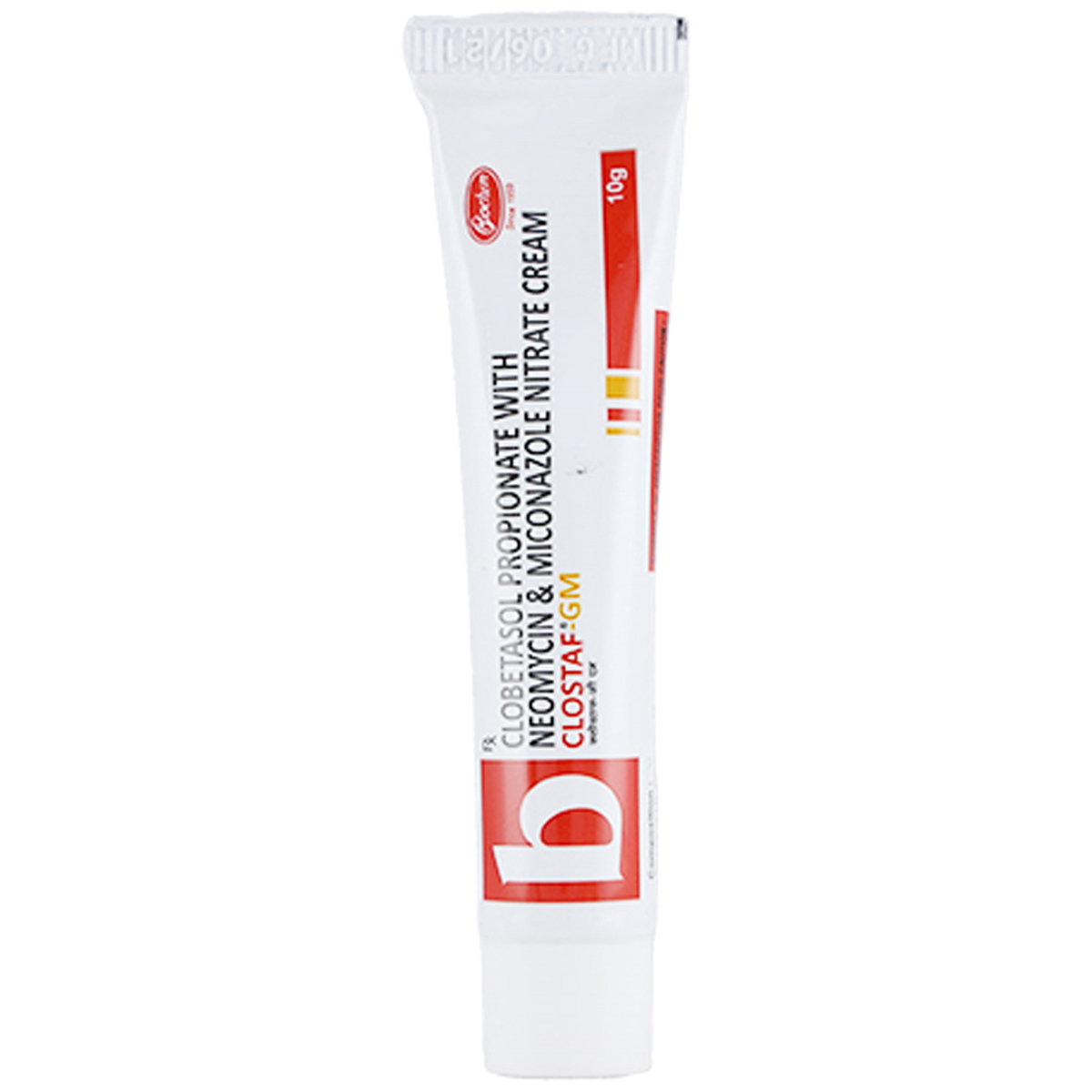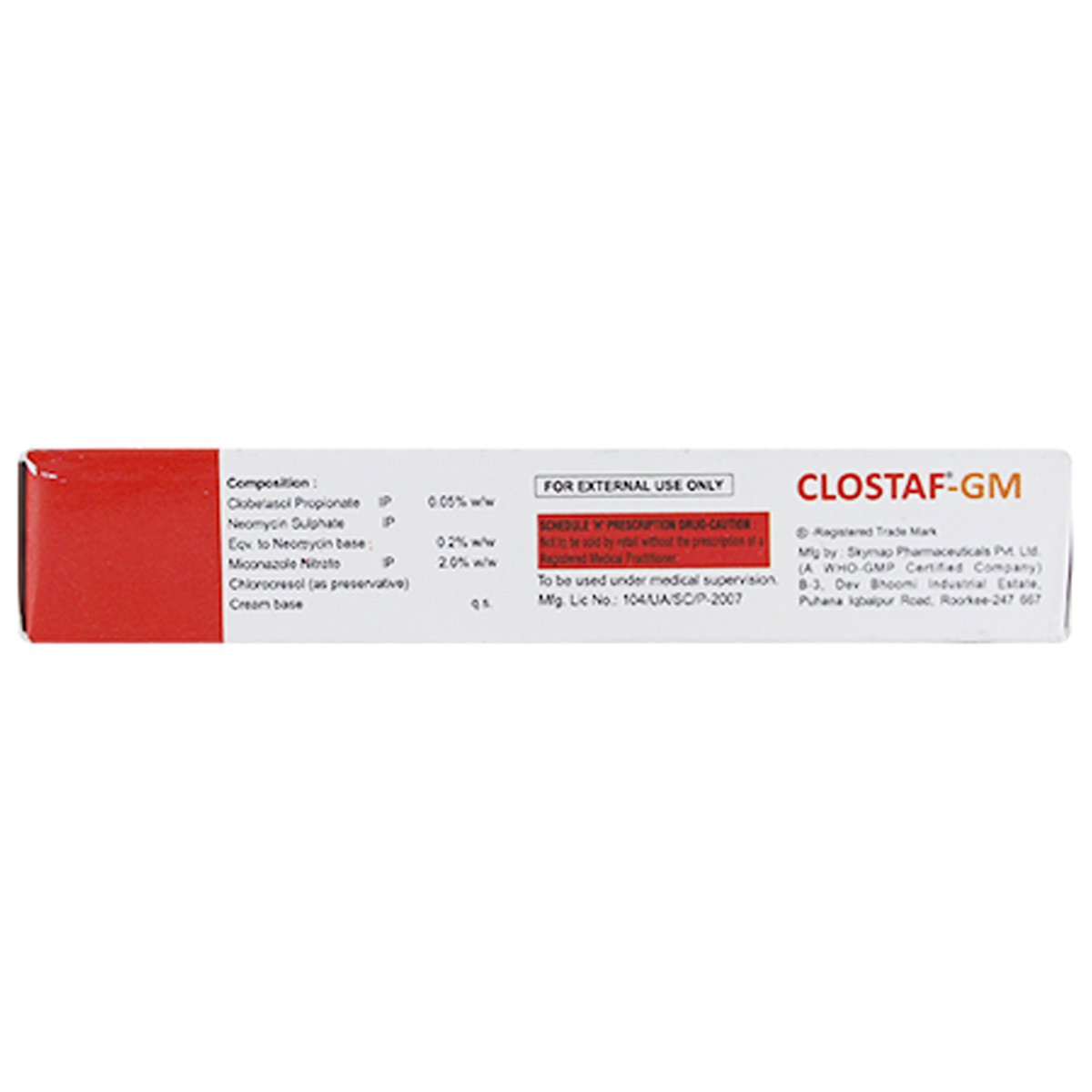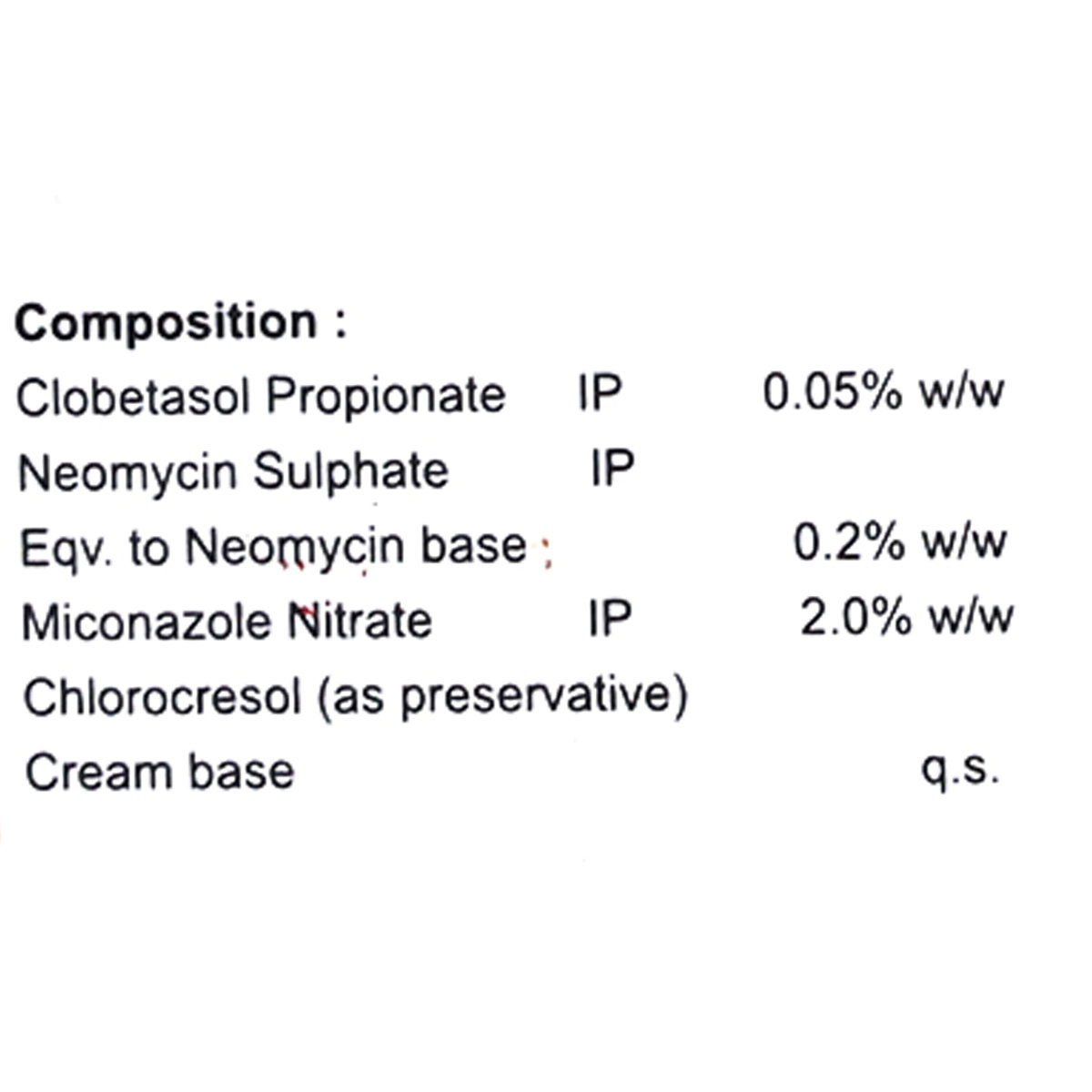Clostaf GM Cream 10 gm








MRP ₹96
(Inclusive of all Taxes)
₹14.4 Cashback (15%)
Provide Delivery Location
Online payment accepted
 Prescription drug
Prescription drugWhats That
Manufacturer/Marketer :
Consume Type :
Return Policy :
Expires on or after :
About Clostafgm Cream
Clostafgm Cream belongs to a group of medications called ‘anti-infectives’ used to treat swelling, itching, and redness caused due to bacterial or fungal skin infections. Clostafgm Cream effectively treats bacterial and fungal skin infections. Bacterial skin infection is a condition in which harmful bacteria grows on the skin and cause infection. They often appear small, red bumps on the skin, which gradually increase in size. Fungal skin infection is a disease in which a fungus attacks the tissue (mostly sweaty areas that don't get enough airflow) and causes an infection.
Clostafgm Cream is a combination of three drugs: Clobetasol, Miconazole, and Neomycin. Clobetasol belongs to the class of corticosteroids. It blocks prostaglandins production (chemical messengers) that cause symptoms of skin infections such as redness, swelling and itching. Miconazole is an antifungal agent that works by causing holes in the fungal cell membranes and kills fungi. Neomycin is an antibiotic. It prevents the synthesis of essential proteins required by bacteria to carry out vital functions.
You should take this medicine as prescribed by your doctor. Clostafgm Cream may cause side effects such as dry skin, burning, irritation, itching, and redness at the application site. These side-effects are mild and temporary. They do not require medical attention and gradually resolve over time. However, if these side effects persist longer, please consult your doctor.
Do not take Clostafgm Cream if you are allergic to any of its components. Before taking Clostafgm Cream, inform your doctor if have any viral infections, acne, rosacea, psoriasis, adrenal gland problems, skin atrophy (thinning of the skin) or liver diseases. Inform your doctor if you are scheduled for any surgery. Also, inform your doctor if you are pregnant or breastfeeding. You should not use Clostafgm Cream cream on broken skin, open wounds or cuts.
Description
Clostaf GM Cream is a potent blend of active ingredients, known for their anti-inflammatory, antifungal, and antibiotic characteristics. This cream contains Clobetasol, Miconazole, and Neomycin which work together to effectively manage a range of skin conditions.
Clostaf GM efficiently treats skin infections instigated by bacteria, fungi, and other microorganisms. It is a proven remedy for inflammation, itching, and redness of the skin. The cream combats fungi by disrupting their protective covering and stops the growth of bacteria. Notably, the Clostaf GM cream also offers quick respite from secondary skin infections. It is user-friendly, easy to apply, and gets swiftly absorbed into the skin for optimal benefits. This combined power of a corticosteroid, antifungal, and antibiotic makes Clostaf GM a comprehensive solution for managing skin infections effectively.
Features
- Incorporates a powerful blend of clobetasol, miconazole, and neomycin
- Easy absorption formula
- Specifically designed for resistant dermatoses
- Triple action offering corticosteroid, antifungal and antibiotic benefits
Uses of Clostafgm Cream
Directions for Use
Medicinal Benefits
Clostafgm Cream is a combination of three drugs: Clobetasol, Miconazole, and Neomycin. Clobetasol is a corticosteroid that inhibits the release of certain chemical messengers in the body that cause redness, itching, and swelling. Miconazole is an antifungal that works by causing holes in the fungal cell membranes and kills fungi. Neomycin is an antibiotic that inhibits the production of essential proteins that are necessary for bacteria to grow, multiply and increase in numbers. Together, Clostafgm Cream can effectively treat skin infections.
Storage
Drug Warnings
Clostafgm Cream is not recommended for use on larger areas of skin. Do not use it for prolonged periods unless prescribed by your doctor. It would be best if you did not cover the treated area with a bandage or plaster, especially the face, without checking with your doctor. Do not use the medicine in and around your eyes. If the medicine accidentally gets into your eyes, nose, mouth, or genitals, rinse with water thoroughly. If you notice any persistent skin irritation or worsening of the skin disease, stop using Clostafgm Cream, and inform your doctor immediately.
Diet & Lifestyle Advise
- Use mild soap while taking baths and prefer warm baths.
- Avoid harsh products on your skin.
- Do not scratch or pick your skin to avoid getting the affected area infected.
- Manage stress, eat healthily, drink plenty of water, exercise regularly and get plenty of sleep.
- Limit food intake that might trigger allergies such as dairy products, soy, eggs and nuts.
- Avoid consumption of foods with excess sugar as it may flare-up inflammation.
- Include fruits, vegetables, whole grains, healthy fats and fish in your diet.
- Avoid getting in contact with harsh soaps, detergents and rough fabrics.
Side Effects of Clostafgm Cream
- Burning sensation on the skin
- Skin irritation
- Itching
- Skin redness
- Thinning of skin
Habit Forming
Therapeutic Class
Safety Information
- This cream should be used with caution and under medical supervision.
- It is not recommended for use in certain conditions such as rosacea, acne vulgaris, and viral infections.
- Avoid using this cream on the face, groin, and skin folds.
- Prevent contact with eyes.
FAQs
Q1. Can I use Clostaf GM Cream on my face?
Ans: No, it is advised to avoid using Clostaf GM Cream on the face. Please consult your healthcare professional for suitable alternatives.
Q2. How long does it take for Clostaf GM Cream to show results?
Ans: The time taken for Clostaf GM Cream to show results may vary depending on the severity of the condition. It is recommended to use the cream as directed by your healthcare professional and continue until the prescribed duration.
Q3. Can I apply other creams or ointments along with Clostaf GM Cream?
Ans: It is advisable to consult your healthcare professional before using other creams or ointments in combination with Clostaf GM Cream to avoid any potential interactions.
Q4. Can I use Clostaf GM Cream during pregnancy or breastfeeding?
Ans: It is recommended to consult your healthcare professional before using Clostaf GM Cream during pregnancy or breastfeeding to assess the potential risks and benefits.
Q5. Can I use Clostaf GM Cream for acne treatment?
Ans: No, Clostaf GM Cream is not recommended for use in acne vulgaris. It is specifically designed to treat resistant dermatoses with secondary bacterial or fungal infections.
Testimonials
'Clostaf GM Cream has been a game-changer for my stubborn skin infections. I highly recommend it.' - Raman Krishna, Teacher, 37
'As a dermatologist, I trust Clostaf GM Cream for its comprehensive treatment approach in skin infections.' - Dr. Vishal Sharma, Dermatologist, 45
'I have tried various creams, but Clostaf GM Cream provided the best results for my skin condition.' - Rishika Chatterjee, Banker, 52
FAQs
Clostafgm Cream is a combination of three drugs: Clobetasol, Miconazole, and Neomycin. Clobetasol is a steroid medicine. It blocks the production of prostaglandins (chemical messengers), which makes the skin red, swollen and itchy. Miconazole is an antifungal agent that works by causing holes in the fungal cell membranes and kills fungi. Neomycin is an antibiotic used in treating bacterial infections of the skin. It prevents the synthesis of essential proteins required by bacteria to carry out vital functions. Together, Clostafgm Cream can effectively treat skin infections.
You may notice an improvement in the symptoms within 2 to 3 days after taking this medicine. The condition usually improves within 2 to 3 weeks. However, if there is no improvement in 3 weeks, consult your doctor immediately.
Clostafgm Cream may cause side effects such as dry skin, burning, irritation, itching, and redness at the application site. These side-effects are mild and temporary. However, if these side effects persist longer, please consult your doctor.
Clostafgm Cream is for topical use (for skin) only. Do not use Clostafgm Cream on the face and avoid contact with eyes, nose, mouth and genitals. Do not put a bandage or a dressing on the affected area while using Clostafgm Cream unless advised by the doctor.
Clostafgm Cream may raise blood glucose levels by interfering with the action of insulin. So, it is recommended to discuss the potential risks and benefits of Clostafgm Cream with your doctor before using it.
No, it is advised to avoid using Clostaf GM Cream on the face. Please consult your healthcare professional for suitable alternatives.
The time taken for Clostaf GM Cream to show results may vary depending on the severity of the condition. It is recommended to use the cream as directed by your healthcare professional and continue until the prescribed duration.
It is advisable to consult your healthcare professional before using other creams or ointments in combination with Clostaf GM Cream to avoid any potential interactions.
It is recommended to consult your healthcare professional before using Clostaf GM Cream during pregnancy or breastfeeding to assess the potential risks and benefits.
No, Clostaf GM Cream is not recommended for use in acne vulgaris. It is specifically designed to treat resistant dermatoses with secondary bacterial or fungal infections.
Drug-Drug Interactions Checker List
- WARFARIN
- DICOUMAROL
- METFORMIN
- BACITRACIN
- POLYMYXIN B
- FUROSEMIDE
Special Advise
- Consult your dermatologist if you notice any improvement in your skin condition after using Clostafgm Cream for 3 to 4 weeks.
- Avoid prolonged treatment. Caution when applied to area near to the eyes.
- Do not use if there is an infection or sore present in the area to be treated.
Disease/Condition Glossary
Bacterial skin infections: Bacterial infection occurs when harmful bacteria grow in the body and causes illness. It can infect any part of the body and multiply very quickly. Some examples of bacterial skin infections are cellulitis (redness and swelling on the legs, especially lower legs) and impetigo (red sores on the face, hands, and feet, mostly seen in children) and staphylococcal infections on the skin (boils or oozing blisters on the skin).
Fungal skin infections: Fungal infection is a skin disease in which a fungus attacks the tissue and cause infection. Fungal infections may be contagious (spread from one person to another). Common types of fungal infections are athlete's foot (infection between the toes) and yeast infections (infections caused by candida in the armpit or groin). Fungal infection symptoms include scaly skin, blisters, itching, swelling, irritation and redness.

Have a query?
Buy best Dermatology products by
Others
AYUR
FIXDERMA
BIODERMA
VENUSIA
CANDID
SELSUN
ABZORB
ATODERM
CIPHANDS
KETO
MINTOP
UVAVO
8X
MELALUMIN
MORR
OILATUM
REJUHAIR
SUNCROS
TETMOSOL
UNISON
UV DOUX
ATBRO SAFEXX
BETADINE
COLOPLAST
DR. MOREPEN
HAIR 4U
LA SCREEN
MEDERMA
RING GUARD
SHYN-ON
SOLSET
SUNSTOP
YUVINIE
A-DERMA
AHD
ALCONANZ
AQUAHOLD
AVARTA
AVENE
BIOLINE
BIOWRIGHT
CETRILAK
CUTICOLOR
CUTILOCK
DANDEL PLUS
DEOPHIN
DOUX
DYSIS
ENMASK 50
EXIZOL
FAIR INSTA
GETRYL
GORGEUS
GUNEERA
HAIR YUTH
HH MITE
I-GLOW
ITCH GUARD
KETOFLY
KETOMAC
KETOPZ
KETOSTAR
KZ
LIPZ
MANKIND
MEDRAYS
MELAGARD
MELNORA BLUV
MICROSTERILE
NO SCARS
OAKNET
ONABET
PARASOFT
PERCOS
PHOTON
PHOTOSTABLE
PHYSIOGEL
PROTEK
RADIBAN
RASHFREE
REGALIZ
RENOCIA
SALISIA
SEBANDRO
SEBORBAR
SESTRY
SOLASAFE
SOLECROSS
STERILLIUM
SUDERMA
SUN KROMA
SUNCLIP
SUNHEAL
SUNMATE
SUNTRIS
TAIYU
TEDIBAR
THERUPTOR
TRICOGRO
Glenmark Pharmaceuticals Ltd
Sun Pharmaceutical Industries Ltd
Klm Laboratories Pvt Ltd
Cipla Ltd
Canixa Life Sciences Pvt Ltd
Abbott India Ltd
Ajanta Pharma Ltd
Intas Pharmaceuticals Ltd
Dr Reddy's Laboratories Ltd
East West Pharma India Pvt Ltd
Alkem Laboratories Ltd
Atopic laboratories Pvt Ltd
Hegde & Hegde Pharmaceutica Llp
Brinton Pharmaceuticals Ltd
Torrent Pharmaceuticals Ltd
Amwill Healthcare Pvt Ltd
Leeford Healthcare Ltd
Palsons Derma Pvt Ltd
Oaknet Healthcare Pvt Ltd
Med Manor Organics Pvt Ltd
Micro Labs Ltd
Dermocare Laboratories Gujarat Llp
Fixderma India Pvt Ltd
Apex Laboratories Pvt Ltd
Mankind Pharma Pvt Ltd
Ipca Laboratories Ltd
Yaher Pharma
Systopic Laboratories Pvt Ltd
Menarini India Pvt Ltd
Ethinext Pharma
Nemus Pharmaceuticals Pvt Ltd
Skinocean Pharmaceuticals
Dermacia Healthcare
Inex Medicaments Pvt Ltd
Lupin Ltd
GlaxoSmithKline Pharmaceuticals Ltd
Talent India Pvt Ltd
Zydus Cadila
Kivi Labs Ltd
Zydus Healthcare Ltd
Hbc Dermiza Healthcare Pvt Ltd
Mrhm Pharma Pvt Ltd
Regaliz Medicare Ltd
Sol Derma Pharmaceuticals Pvt Ltd
Newtrimed Healthcare Pvt Ltd
Wallace Pharmaceuticals Pvt Ltd
Eskon Pharma
Glowderma Lab Pvt Ltd
La Pristine Bioceuticals Pvt Ltd
Mohrish Pharmaceuticals Pvt Ltd
Percos India Pvt Ltd
Rockmed Pharma Pvt Ltd
Macleods Pharmaceuticals Ltd
Praise Pharma
Ethicare Remedies Pvt Ltd
Kaizen Drugs Pvt Ltd
Aurel Biolife
Rely On Pharmaceuticals
Wockhardt Ltd
Galcare Pharmaceuticals Pvt Ltd
Elder Pharmaceuticals Ltd
Indiabulls Pharmaceuticals Pvt Ltd
La Med Healthcare Pvt Ltd
Biocute Life Care
Yap Bioceuticals
Yash Pharma Laboratories Pvt Ltd
Zee Laboratories Ltd
Apple Therapeutics Pvt Ltd
Adonis Laboratories Pvt Ltd
Albatross Healthcare Pvt Ltd
Galderma India Pvt Ltd
Prism Life Sciences Ltd
FDC Ltd
Alniche Life Sciences Pvt Ltd
Salve Pharmaceuticals Pvt Ltd
West Coast Pharmaceuticals Pvt Ltd
Dermarex HealthCare India Pvt Ltd
Arka Vital Science Pvt Ltd
Dermajoint India
Gary Pharmaceuticals Pvt Ltd
Grace Derma Healthcare Pvt Ltd
Karlin Pharmaceuticals & Exports Pvt Ltd
Skinska Pharmaceutica Pvt Ltd
Uniza Healthcare Llp
Alembic Pharmaceuticals Ltd
Cadila Healthcare Ltd
Cadila Pharmaceuticals Ltd
Cosmofix Technovation Pvt Ltd
Human Pharmaceuticals
Indolands Pharma Pvt Ltd
Lyra Laboratories Pvt Ltd
Akumentis Healthcare Ltd
Entod Pharmaceuticals Ltd
Iceberg Health Care Pvt Ltd
Jenburkt Pharmaceuticals Ltd
P and P Dermaceuticals Pvt Ltd
Dabur India Ltd
Indchemie Health Specialities Pvt Ltd
Olcare Laboratories Pvt Ltd
Unison Pharmaceuticals Pvt Ltd
BODY CREAM
Body Lotion
Face Cream
Shampoo
Sun Screen
Face Gel
Soap
Face Wash
HAIR SOLUTION
Face Serum
BODY GEL
Hair Lotion
Hair Serum
Dusting Powder
ANTISEPTIC
FACE CLEANSER
Face Lotion
Body Wash
Body Spray
Eye Cream
FUNGAL INFECTION
Foot Cream
Conditioner
Eye Gel
Cleanser
Hair Cream
Hair Oil
Face Mask
Hair Gel
Sanitizer
Hair Spray
Moisturiser
Skin Ointment
Lip Balm
Capsule
Eye Serum
Intimate Wash
Specialty Supplements
Hand Cream
Facial Spray
SPECIALITY SUPPLEMENT
Face Toner
MEDICATED SHAMPOO
Tablet
Talcum Powder
BABY SUNSCREEN
Body Butter
Body Scrub
DIAPER RASH CREAM
EYE SOLUTION
FACIAL WIPE
Gargle
Hand Wash
Intimate Spray
Lip Serum
Lubricant Gel
MEDICATED CREAM
Nail Polish
VITAMIN D
Alcohol
Caution
Alcohol may interfere with your ability to fight infections. So, it is advised to limit consumption of alcohol.
Pregnancy
Caution
Clostafgm Cream is a category C medicine and may harm the fetus or unborn baby. So, it should be used with caution in pregnant women.
Breast Feeding
Caution
Clostafgm Cream may pass into breast milk, so it should be used with caution in breastfeeding mothers.
Driving
Safe if prescribed
Clostafgm Cream may not affect your ability to drive.
Liver
Caution
Clostafgm Cream should be used with caution in patients with liver diseases. Your doctor prescribes this after weighing the benefits with any potential risks.
Kidney
Safe if prescribed
Clostafgm Cream is probably safe when used in patients with kidney diseases.
Children
Caution
The safety of Clostafgm Cream in children is unknown. Please consult a doctor before using Clostafgm Cream on your child.





